Blog
How Is PAD Diagnosed?
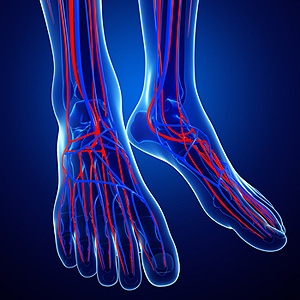 There are common symptoms that many patients experience with peripheral artery disease (PAD). These can include cramping in the legs and feet while walking or exercising, foot wounds that have difficulty healing, and coldness in the feet. This condition can develop as a result of blocked arteries, and cramps are the body’s natural warning method of having inadequate blood flow. A proper diagnosis may include having a test performed that can check the blood pressure in the feet, which can be compared to the blood pressure in the arm. If there is an abnormal difference between the two, additional testing may be performed. If you feel you have symptoms of PAD, it is suggested that you schedule a consultation with a podiatrist who can properly diagnose and treat this condition.
There are common symptoms that many patients experience with peripheral artery disease (PAD). These can include cramping in the legs and feet while walking or exercising, foot wounds that have difficulty healing, and coldness in the feet. This condition can develop as a result of blocked arteries, and cramps are the body’s natural warning method of having inadequate blood flow. A proper diagnosis may include having a test performed that can check the blood pressure in the feet, which can be compared to the blood pressure in the arm. If there is an abnormal difference between the two, additional testing may be performed. If you feel you have symptoms of PAD, it is suggested that you schedule a consultation with a podiatrist who can properly diagnose and treat this condition.
Peripheral artery disease can pose a serious risk to your health. It can increase the risk of stroke and heart attack. If you have symptoms of peripheral artery disease, consult with one of our podiatrists from The Podiatry Center, PC. Our doctors will assess your condition and provide you with quality foot and ankle treatment.
Peripheral artery disease (PAD) is when arteries are constricted due to plaque (fatty deposits) build-up. This results in less blood flow to the legs and other extremities. The main cause of PAD is atherosclerosis, in which plaque builds up in the arteries.
Symptoms
Symptoms of PAD include:
- Claudication (leg pain from walking)
- Numbness in legs
- Decrease in growth of leg hair and toenails
- Paleness of the skin
- Erectile dysfunction
- Sores and wounds on legs and feet that won’t heal
- Coldness in one leg
It is important to note that a majority of individuals never show any symptoms of PAD.
Diagnosis
While PAD occurs in the legs and arteries, Podiatrists can diagnose PAD. Podiatrists utilize a test called an ankle-brachial index (ABI). An ABI test compares blood pressure in your arm to you ankle to see if any abnormality occurs. Ultrasound and imaging devices may also be used.
Treatment
Fortunately, lifestyle changes such as maintaining a healthy diet, exercising, managing cholesterol and blood sugar levels, and quitting smoking, can all treat PAD. Medications that prevent clots from occurring can be prescribed. Finally, in some cases, surgery may be recommended.
If you have any questions, please feel free to contact our office located in Millburn, NJ . We offer the newest diagnostic and treatment technologies for all your foot care needs.
What Is The Common Age Group That Is Affected By Gout?
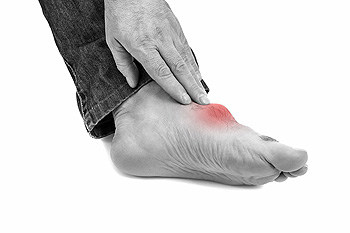 The painful foot condition that is known as gout typically occurs in men who are between forty and fifty years old. There may be existing factors that can lead to the formation of gout. These can consist of genetic factors, being overweight, and consuming foods that are rich in purines. Additionally, people who have high blood pressure, thyroid conditions, or kidney failure may be susceptible to developing gout. It occurs as a result of excess uric acid in the bloodstream and can cause sensations that resemble crystals attacking the joints in the feet and hands. Common symptoms often include extreme pain and discomfort in the big toe and surrounding area, and it may become difficult to walk. If you are afflicted with gout attacks, it is strongly advised that you are under the care of a podiatrist who can properly treat this condition.
The painful foot condition that is known as gout typically occurs in men who are between forty and fifty years old. There may be existing factors that can lead to the formation of gout. These can consist of genetic factors, being overweight, and consuming foods that are rich in purines. Additionally, people who have high blood pressure, thyroid conditions, or kidney failure may be susceptible to developing gout. It occurs as a result of excess uric acid in the bloodstream and can cause sensations that resemble crystals attacking the joints in the feet and hands. Common symptoms often include extreme pain and discomfort in the big toe and surrounding area, and it may become difficult to walk. If you are afflicted with gout attacks, it is strongly advised that you are under the care of a podiatrist who can properly treat this condition.
Gout is a painful condition that can be treated. If you are seeking treatment, contact one of our podiatrists from The Podiatry Center, PC. Our doctors will treat your foot and ankle needs.
What Is Gout?
Gout is a form of arthritis that is characterized by sudden, severe attacks of pain, redness, and tenderness in the joints. The condition usually affects the joint at the base of the big toe. A gout attack can occur at any random time, such as the middle of the night while you are asleep.
Symptoms
- Intense Joint Pain - Usually around the large joint of your big toe, and it most severe within the first four to twelve hours
- Lingering Discomfort - Joint discomfort may last from a few days to a few weeks
- Inflammation and Redness -Affected joints may become swollen, tender, warm and red
- Limited Range of Motion - May experience a decrease in joint mobility
Risk Factors
- Genetics - If family members have gout, you’re more likely to have it
- Medications - Diuretic medications can raise uric acid levels
- Gender/Age - Gout is more common in men until the age of 60. It is believed that estrogen protects women until that point
- Diet - Eating red meat and shellfish increases your risk
- Alcohol - Having more than two alcoholic drinks per day increases your risk
- Obesity - Obese people are at a higher risk for gout
Prior to visiting your podiatrist to receive treatment for gout, there are a few things you should do beforehand. If you have gout you should write down your symptoms--including when they started and how often you experience them, important medical information you may have, and any questions you may have. Writing down these three things will help your podiatrist in assessing your specific situation so that he or she may provide the best route of treatment for you.
If you have any questions, please feel free to contact our office located in Millburn, NJ. We offer the newest diagnostic and treatment technologies for all your foot care needs.
Read more about Everything You Need to Know About GoutWhat Is The Common Age Group That Is Affected By Gout?
 The painful foot condition that is known as gout typically occurs in men who are between forty and fifty years old. There may be existing factors that can lead to the formation of gout. These can consist of genetic factors, being overweight, and consuming foods that are rich in purines. Additionally, people who have high blood pressure, thyroid conditions, or kidney failure may be susceptible to developing gout. It occurs as a result of excess uric acid in the bloodstream and can cause sensations that resemble crystals attacking the joints in the feet and hands. Common symptoms often include extreme pain and discomfort in the big toe and surrounding area, and it may become difficult to walk. If you are afflicted with gout attacks, it is strongly advised that you are under the care of a podiatrist who can properly treat this condition.
The painful foot condition that is known as gout typically occurs in men who are between forty and fifty years old. There may be existing factors that can lead to the formation of gout. These can consist of genetic factors, being overweight, and consuming foods that are rich in purines. Additionally, people who have high blood pressure, thyroid conditions, or kidney failure may be susceptible to developing gout. It occurs as a result of excess uric acid in the bloodstream and can cause sensations that resemble crystals attacking the joints in the feet and hands. Common symptoms often include extreme pain and discomfort in the big toe and surrounding area, and it may become difficult to walk. If you are afflicted with gout attacks, it is strongly advised that you are under the care of a podiatrist who can properly treat this condition.
Gout is a painful condition that can be treated. If you are seeking treatment, contact one of our podiatrists from The Podiatry Center, PC. Our doctors will treat your foot and ankle needs.
What Is Gout?
Gout is a form of arthritis that is characterized by sudden, severe attacks of pain, redness, and tenderness in the joints. The condition usually affects the joint at the base of the big toe. A gout attack can occur at any random time, such as the middle of the night while you are asleep.
Symptoms
- Intense Joint Pain - Usually around the large joint of your big toe, and it most severe within the first four to twelve hours
- Lingering Discomfort - Joint discomfort may last from a few days to a few weeks
- Inflammation and Redness -Affected joints may become swollen, tender, warm and red
- Limited Range of Motion - May experience a decrease in joint mobility
Risk Factors
- Genetics - If family members have gout, you’re more likely to have it
- Medications - Diuretic medications can raise uric acid levels
- Gender/Age - Gout is more common in men until the age of 60. It is believed that estrogen protects women until that point
- Diet - Eating red meat and shellfish increases your risk
- Alcohol - Having more than two alcoholic drinks per day increases your risk
- Obesity - Obese people are at a higher risk for gout
Prior to visiting your podiatrist to receive treatment for gout, there are a few things you should do beforehand. If you have gout you should write down your symptoms--including when they started and how often you experience them, important medical information you may have, and any questions you may have. Writing down these three things will help your podiatrist in assessing your specific situation so that he or she may provide the best route of treatment for you.
If you have any questions, please feel free to contact our office located in Millburn, NJ . We offer the newest diagnostic and treatment technologies for all your foot care needs.
Are You Suffering From Ingrown Toenails?
Are You Suffering From Ingrown Toenails?
Heel Pain Is Indicative of Common Foot Conditions
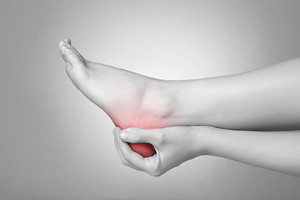 There are many forms of heel pain that people around the world may exhibit. Research has indicated it often occurs gradually, and may develop due to a variety of reasons. Plantar fasciitis affects the tendon that connects the toes to the heel, and severe pain is often felt in the heel and arch area. Teenagers who are physically active may experience heel pain, which can be indicative of Sever’s disease. This condition affects the growth plate in the heel. Mild relief may be found when the activity that caused it is stopped temporarily, as this can accelerate the healing process. Many types of moderate heel pain can be treated with rest, elevation, and possibly performing gentle stretches. If you have any indication of heel pain, it is suggested that you are under the care of a podiatrist.
There are many forms of heel pain that people around the world may exhibit. Research has indicated it often occurs gradually, and may develop due to a variety of reasons. Plantar fasciitis affects the tendon that connects the toes to the heel, and severe pain is often felt in the heel and arch area. Teenagers who are physically active may experience heel pain, which can be indicative of Sever’s disease. This condition affects the growth plate in the heel. Mild relief may be found when the activity that caused it is stopped temporarily, as this can accelerate the healing process. Many types of moderate heel pain can be treated with rest, elevation, and possibly performing gentle stretches. If you have any indication of heel pain, it is suggested that you are under the care of a podiatrist.
Many people suffer from bouts of heel pain. For more information, contact one of our podiatrists of The Podiatry Center, PC. Our doctors can provide the care you need to keep you pain-free and on your feet.
Causes of Heel Pain
Heel pain is often associated with plantar fasciitis. The plantar fascia is a band of tissues that extends along the bottom of the foot. A rip or tear in this ligament can cause inflammation of the tissue.
Achilles tendonitis is another cause of heel pain. Inflammation of the Achilles tendon will cause pain from fractures and muscle tearing. Lack of flexibility is also another symptom.
Heel spurs are another cause of pain. When the tissues of the plantar fascia undergo a great deal of stress, it can lead to ligament separation from the heel bone, causing heel spurs.
Why Might Heel Pain Occur?
- Wearing ill-fitting shoes
- Wearing non-supportive shoes
- Weight change
- Excessive running
Treatments
Heel pain should be treated as soon as possible for immediate results. Keeping your feet in a stress-free environment will help. If you suffer from Achilles tendonitis or plantar fasciitis, applying ice will reduce the swelling. Stretching before an exercise like running will help the muscles. Using all these tips will help make heel pain a condition of the past.
If you have any questions please contact our office located in Millburn, NJ. We offer the newest diagnostic and treatment technologies for all your foot and ankle needs.
Read more about Heel PainHeel Pain Is Indicative of Common Foot Conditions
 There are many forms of heel pain that people around the world may exhibit. Research has indicated it often occurs gradually, and may develop due to a variety of reasons. Plantar fasciitis affects the tendon that connects the toes to the heel, and severe pain is often felt in the heel and arch area. Teenagers who are physically active may experience heel pain, which can be indicative of Sever’s disease. This condition affects the growth plate in the heel. Mild relief may be found when the activity that caused it is stopped temporarily, as this can accelerate the healing process. Many types of moderate heel pain can be treated with rest, elevation, and possibly performing gentle stretches. If you have any indication of heel pain, it is suggested that you are under the care of a podiatrist.
There are many forms of heel pain that people around the world may exhibit. Research has indicated it often occurs gradually, and may develop due to a variety of reasons. Plantar fasciitis affects the tendon that connects the toes to the heel, and severe pain is often felt in the heel and arch area. Teenagers who are physically active may experience heel pain, which can be indicative of Sever’s disease. This condition affects the growth plate in the heel. Mild relief may be found when the activity that caused it is stopped temporarily, as this can accelerate the healing process. Many types of moderate heel pain can be treated with rest, elevation, and possibly performing gentle stretches. If you have any indication of heel pain, it is suggested that you are under the care of a podiatrist.
Many people suffer from bouts of heel pain. For more information, contact one of our podiatrists of The Podiatry Center, PC. Our doctors can provide the care you need to keep you pain-free and on your feet.
Causes of Heel Pain
Heel pain is often associated with plantar fasciitis. The plantar fascia is a band of tissues that extends along the bottom of the foot. A rip or tear in this ligament can cause inflammation of the tissue.
Achilles tendonitis is another cause of heel pain. Inflammation of the Achilles tendon will cause pain from fractures and muscle tearing. Lack of flexibility is also another symptom.
Heel spurs are another cause of pain. When the tissues of the plantar fascia undergo a great deal of stress, it can lead to ligament separation from the heel bone, causing heel spurs.
Why Might Heel Pain Occur?
- Wearing ill-fitting shoes
- Wearing non-supportive shoes
- Weight change
- Excessive running
Treatments
Heel pain should be treated as soon as possible for immediate results. Keeping your feet in a stress-free environment will help. If you suffer from Achilles tendonitis or plantar fasciitis, applying ice will reduce the swelling. Stretching before an exercise like running will help the muscles. Using all these tips will help make heel pain a condition of the past.
If you have any questions please contact our office located in Millburn, NJ . We offer the newest diagnostic and treatment technologies for all your foot and ankle needs.
Why Caring for Wounds is Especially Important for Diabetic Patients
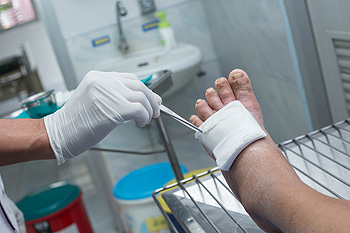 Diabetic patients tend to have a higher chance of developing foot conditions, most commonly, foot ulcers. A foot ulcer can be defined as an open sore that heals slowly. This condition typically affects a patient’s big toe, or the ball of the foot. Diabetic patients are more at risk for developing a foot ulcer for a variety of reasons, including nerve damage. Because nerve damage can cause a loss of feeling in the feet, diabetic patients may not always be aware if they have injured their feet or have developed a wound. If wounds are left untreated for too long, it is likely for an infection to develop, causing more severe foot damage. To help prevent wounds on the feet from causing serious harm, it’s suggested that if you are a diabetic patient, you check your feet on a daily basis for any abnormalities. For more information on wound care, please speak with a podiatrist for professional care.
Diabetic patients tend to have a higher chance of developing foot conditions, most commonly, foot ulcers. A foot ulcer can be defined as an open sore that heals slowly. This condition typically affects a patient’s big toe, or the ball of the foot. Diabetic patients are more at risk for developing a foot ulcer for a variety of reasons, including nerve damage. Because nerve damage can cause a loss of feeling in the feet, diabetic patients may not always be aware if they have injured their feet or have developed a wound. If wounds are left untreated for too long, it is likely for an infection to develop, causing more severe foot damage. To help prevent wounds on the feet from causing serious harm, it’s suggested that if you are a diabetic patient, you check your feet on a daily basis for any abnormalities. For more information on wound care, please speak with a podiatrist for professional care.
Wound care is an important part in dealing with diabetes. If you have diabetes and a foot wound or would like more information about wound care for diabetics, consult with one of our podiatrists from The Podiatry Center, PC. Our doctors will assess your condition and provide you with quality foot and ankle treatment.
What Is Wound Care?
Wound care is the practice of taking proper care of a wound. This can range from the smallest to the largest of wounds. While everyone can benefit from proper wound care, it is much more important for diabetics. Diabetics often suffer from poor blood circulation which causes wounds to heal much slower than they would in a non-diabetic.
What Is the Importance of Wound Care?
While it may not seem apparent with small ulcers on the foot, for diabetics, any size ulcer can become infected. Diabetics often also suffer from neuropathy, or nerve loss. This means they might not even feel when they have an ulcer on their foot. If the wound becomes severely infected, amputation may be necessary. Therefore, it is of the upmost importance to properly care for any and all foot wounds.
How to Care for Wounds
The best way to care for foot wounds is to prevent them. For diabetics, this means daily inspections of the feet for any signs of abnormalities or ulcers. It is also recommended to see a podiatrist several times a year for a foot inspection. If you do have an ulcer, run the wound under water to clear dirt from the wound; then apply antibiotic ointment to the wound and cover with a bandage. Bandages should be changed daily and keeping pressure off the wound is smart. It is advised to see a podiatrist, who can keep an eye on it.
If you have any questions, please feel free to contact our office located in Millburn, NJ. We offer the newest diagnostic and treatment technologies for all your foot care needs.
Read more about Wound CareWhy Caring for Wounds is Especially Important for Diabetic Patients
 Diabetic patients tend to have a higher chance of developing foot conditions, most commonly, foot ulcers. A foot ulcer can be defined as an open sore that heals slowly. This condition typically affects a patient’s big toe, or the ball of the foot. Diabetic patients are more at risk for developing a foot ulcer for a variety of reasons, including nerve damage. Because nerve damage can cause a loss of feeling in the feet, diabetic patients may not always be aware if they have injured their feet or have developed a wound. If wounds are left untreated for too long, it is likely for an infection to develop, causing more severe foot damage. To help prevent wounds on the feet from causing serious harm, it’s suggested that if you are a diabetic patient, you check your feet on a daily basis for any abnormalities. For more information on wound care, please speak with a podiatrist for professional care.
Diabetic patients tend to have a higher chance of developing foot conditions, most commonly, foot ulcers. A foot ulcer can be defined as an open sore that heals slowly. This condition typically affects a patient’s big toe, or the ball of the foot. Diabetic patients are more at risk for developing a foot ulcer for a variety of reasons, including nerve damage. Because nerve damage can cause a loss of feeling in the feet, diabetic patients may not always be aware if they have injured their feet or have developed a wound. If wounds are left untreated for too long, it is likely for an infection to develop, causing more severe foot damage. To help prevent wounds on the feet from causing serious harm, it’s suggested that if you are a diabetic patient, you check your feet on a daily basis for any abnormalities. For more information on wound care, please speak with a podiatrist for professional care.
Wound care is an important part in dealing with diabetes. If you have diabetes and a foot wound or would like more information about wound care for diabetics, consult with one of our podiatrists from The Podiatry Center, PC. Our doctors will assess your condition and provide you with quality foot and ankle treatment.
What Is Wound Care?
Wound care is the practice of taking proper care of a wound. This can range from the smallest to the largest of wounds. While everyone can benefit from proper wound care, it is much more important for diabetics. Diabetics often suffer from poor blood circulation which causes wounds to heal much slower than they would in a non-diabetic.
What Is the Importance of Wound Care?
While it may not seem apparent with small ulcers on the foot, for diabetics, any size ulcer can become infected. Diabetics often also suffer from neuropathy, or nerve loss. This means they might not even feel when they have an ulcer on their foot. If the wound becomes severely infected, amputation may be necessary. Therefore, it is of the upmost importance to properly care for any and all foot wounds.
How to Care for Wounds
The best way to care for foot wounds is to prevent them. For diabetics, this means daily inspections of the feet for any signs of abnormalities or ulcers. It is also recommended to see a podiatrist several times a year for a foot inspection. If you do have an ulcer, run the wound under water to clear dirt from the wound; then apply antibiotic ointment to the wound and cover with a bandage. Bandages should be changed daily and keeping pressure off the wound is smart. It is advised to see a podiatrist, who can keep an eye on it.
If you have any questions, please feel free to contact our office located in Millburn, NJ . We offer the newest diagnostic and treatment technologies for all your foot care needs.
Reminder: When Was the Last Time...?
More...
Reminder: When Was the Last Time...?
Methods for Stretching the Feet
 When the feet are properly stretched, it may positively affect the well-being of the overall body. The feet are considered to be the foundation of the body, which is why it’s important to practice effective ways to stretch different areas of the feet. When your foot is rolled on a tennis ball, you may feel the muscles quickly relax. This can be helpful after standing or walking for the majority of the day. Some patients find it beneficial to stand on their tip toes for several seconds, as this may help to relax the muscles, ligaments, and tendons. People who have flat feet may find it useful to stretch the arch, which can be accomplished by standing on the floor and gently lifting the toes. If you would like additional methods for stretching your feet, please consult with a podiatrist.
When the feet are properly stretched, it may positively affect the well-being of the overall body. The feet are considered to be the foundation of the body, which is why it’s important to practice effective ways to stretch different areas of the feet. When your foot is rolled on a tennis ball, you may feel the muscles quickly relax. This can be helpful after standing or walking for the majority of the day. Some patients find it beneficial to stand on their tip toes for several seconds, as this may help to relax the muscles, ligaments, and tendons. People who have flat feet may find it useful to stretch the arch, which can be accomplished by standing on the floor and gently lifting the toes. If you would like additional methods for stretching your feet, please consult with a podiatrist.
Stretching the feet is a great way to prevent injuries. If you have any concerns with your feet consult with one of our podiatrists from The Podiatry Center, PC. Our doctors will assess your condition and provide you with quality foot and ankle treatment.
Stretching the Feet
Being the backbone of the body, the feet carry your entire weight and can easily become overexerted, causing cramps and pain. As with any body part, stretching your feet can serve many benefits. From increasing flexibility to even providing some pain relief, be sure to give your feet a stretch from time to time. This is especially important for athletes or anyone performing aerobic exercises, but anyone experiencing foot pain or is on their feet constantly should also engage in this practice.
Great ways to stretch your feet:
- Crossing one leg over the others and carefully pull your toes back. Do 10-20 repetitions and repeat the process for each foot
- Face a wall with your arms out and hands flat against the wall. Step back with one foot and keep it flat on the floor while moving the other leg forward. Lean towards the wall until you feel a stretch. Hold for 30 seconds and perform 10 repetitions for each foot
- Be sure not to overextend or push your limbs too hard or you could risk pulling or straining your muscle
Individuals who tend to their feet by regular stretching every day should be able to minimize foot pain and prevent new problems from arising.
If you have any questions, please feel free to contact our office located in Millburn, NJ. We offer the newest diagnostic and treatment technologies for all your foot care needs.
Read more about How to Stretch Your FeetMethods for Stretching the Feet
 When the feet are properly stretched, it may positively affect the well-being of the overall body. The feet are considered to be the foundation of the body, which is why it’s important to practice effective ways to stretch different areas of the feet. When your foot is rolled on a tennis ball, you may feel the muscles quickly relax. This can be helpful after standing or walking for the majority of the day. Some patients find it beneficial to stand on their tip toes for several seconds, as this may help to relax the muscles, ligaments, and tendons. People who have flat feet may find it useful to stretch the arch, which can be accomplished by standing on the floor and gently lifting the toes. If you would like additional methods for stretching your feet, please consult with a podiatrist.
When the feet are properly stretched, it may positively affect the well-being of the overall body. The feet are considered to be the foundation of the body, which is why it’s important to practice effective ways to stretch different areas of the feet. When your foot is rolled on a tennis ball, you may feel the muscles quickly relax. This can be helpful after standing or walking for the majority of the day. Some patients find it beneficial to stand on their tip toes for several seconds, as this may help to relax the muscles, ligaments, and tendons. People who have flat feet may find it useful to stretch the arch, which can be accomplished by standing on the floor and gently lifting the toes. If you would like additional methods for stretching your feet, please consult with a podiatrist.
Stretching the feet is a great way to prevent injuries. If you have any concerns with your feet consult with one of our podiatrists from The Podiatry Center, PC. Our doctors will assess your condition and provide you with quality foot and ankle treatment.
Stretching the Feet
Being the backbone of the body, the feet carry your entire weight and can easily become overexerted, causing cramps and pain. As with any body part, stretching your feet can serve many benefits. From increasing flexibility to even providing some pain relief, be sure to give your feet a stretch from time to time. This is especially important for athletes or anyone performing aerobic exercises, but anyone experiencing foot pain or is on their feet constantly should also engage in this practice.
Great ways to stretch your feet:
- Crossing one leg over the others and carefully pull your toes back. Do 10-20 repetitions and repeat the process for each foot
- Face a wall with your arms out and hands flat against the wall. Step back with one foot and keep it flat on the floor while moving the other leg forward. Lean towards the wall until you feel a stretch. Hold for 30 seconds and perform 10 repetitions for each foot
- Be sure not to overextend or push your limbs too hard or you could risk pulling or straining your muscle
Individuals who tend to their feet by regular stretching every day should be able to minimize foot pain and prevent new problems from arising.
If you have any questions, please feel free to contact our office located in Millburn, NJ . We offer the newest diagnostic and treatment technologies for all your foot care needs.
Methods That May Help to Prevent Falling
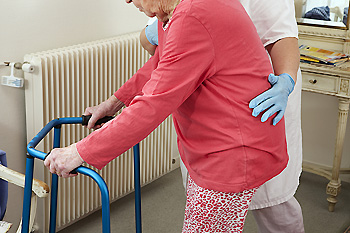 It is crucial for elderly patients to protect themselves in their homes. This may be helpful in preventing falling, which can cause serious health issues and complications with the feet. It may be beneficial to slow your pace as you walk and complete tasks in your home. Additionally, it can help to wear slippers that have a non-slip sole. Research has indicated that when grab bars are installed in the shower and bath area, the risk of falling may be reduced. It is important to have routine medical exams so current prescriptions may be evaluated, in addition to having a thorough eye exam. If you would like more information about falls prevention techniques and how to help protect your feet, it’s suggested that you consult with a podiatrist.
It is crucial for elderly patients to protect themselves in their homes. This may be helpful in preventing falling, which can cause serious health issues and complications with the feet. It may be beneficial to slow your pace as you walk and complete tasks in your home. Additionally, it can help to wear slippers that have a non-slip sole. Research has indicated that when grab bars are installed in the shower and bath area, the risk of falling may be reduced. It is important to have routine medical exams so current prescriptions may be evaluated, in addition to having a thorough eye exam. If you would like more information about falls prevention techniques and how to help protect your feet, it’s suggested that you consult with a podiatrist.
Preventing falls among the elderly is very important. If you are older and have fallen or fear that you are prone to falling, consult with one of our podiatrists from The Podiatry Center, PC. Our doctors will assess your condition and provide you with quality advice and care.
Every 11 seconds, an elderly American is being treated in an emergency room for a fall related injury. Falls are the leading cause of head and hip injuries for those 65 and older. Due to decreases in strength, balance, senses, and lack of awareness, elderly persons are very susceptible to falling. Thankfully, there are a number of things older persons can do to prevent falls.
How to Prevent Falls
Some effective methods that older persons can do to prevent falls include:
- Enrolling in strength and balance exercise program to increase balance and strength
- Periodically having your sight and hearing checked
- Discuss any medications you have with a doctor to see if it increases the risk of falling
- Clearing the house of falling hazards and installing devices like grab bars and railings
- Utilizing a walker or cane
- Wearing shoes that provide good support and cushioning
- Talking to family members about falling and increasing awareness
Falling can be a traumatic and embarrassing experience for elderly persons; this can make them less willing to leave the house, and less willing to talk to someone about their fears of falling. Doing such things, however, will increase the likelihood of tripping or losing one’s balance. Knowing the causes of falling and how to prevent them is the best way to mitigate the risk of serious injury.
If you have any questions, please feel free to contact our office located in Millburn, NJ. We offer the newest diagnostic and treatment technologies for all your foot care needs.
Read more about Falls Prevention



